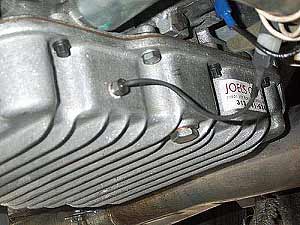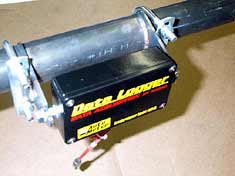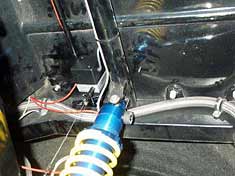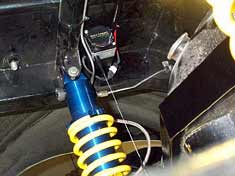
Depending upon the application, you might
want to measure transmission oil temperature.
As you can see, the sensor installation
isn't difficult. It mounts in a manner that's
similar to a conventional transmission temperature
gauge, with the probe installed directly
in the oil pan. |

6. The pressure
sensors supplied with the computer are very
accurate and they are also very sensitive. For
best results mount sensors away from direct
engine heat or engine and chassis vibrations.
The sensors are rugged and can handle the vibration,
but sensor readings may show vibration "noise".
The maximum operating temperatures of the sensors
is 210 degrees F. Be sure to isolate the sensors
from elevated temperature. If readings are taken
directly from the engine, isolate the sensor
from hot components by adding tubing (such as
braided AN hose) between the sensor and the
engine. When installing the sensors with Teflon
tape, start the Teflon tape after the first
two full threads. Prevent any component from
touching an exhaust manifold, header or exhaust.
If measuring boost pressure
ADVERTISEMENT
 |
where
the temperature exceeds 200 degrees F, isolate
the sensor from hot gasses by adding tubing
between the sensor and the manifold.
7. Wiring the power
harness: Connect the red wire to 12 volt positive
and the black wire to the battery ground. Connect
the "chassis" lug or gray wire (on the rear
of computer) to a separate chassis ground (not
the same ground as the black wire) using 16-gauge
wire or larger. This provides a shield for signal
cables.
8. Position EGT
cables clear of all other wiring for best noise
isolation. (avoid spark plug wires or any ignition
wiring).
 |
 |
| The shock travel sensors
are mounted in such a way that they have
adequate capacity to measure the complete
range of suspension travel. As you can see
in this photo, one off the sensors is mounted
on aspecially fabricated bracket, which
affixes it to the chassis. A similar bracket
is mounted on the driver's side of the car. |
 |

|